Sourdough Rye English Muffins
Wondering what to do with your sourdough discard? These English muffins minimize starter waste and they’re the easiest bread recipe you’ll have in your repertoire.
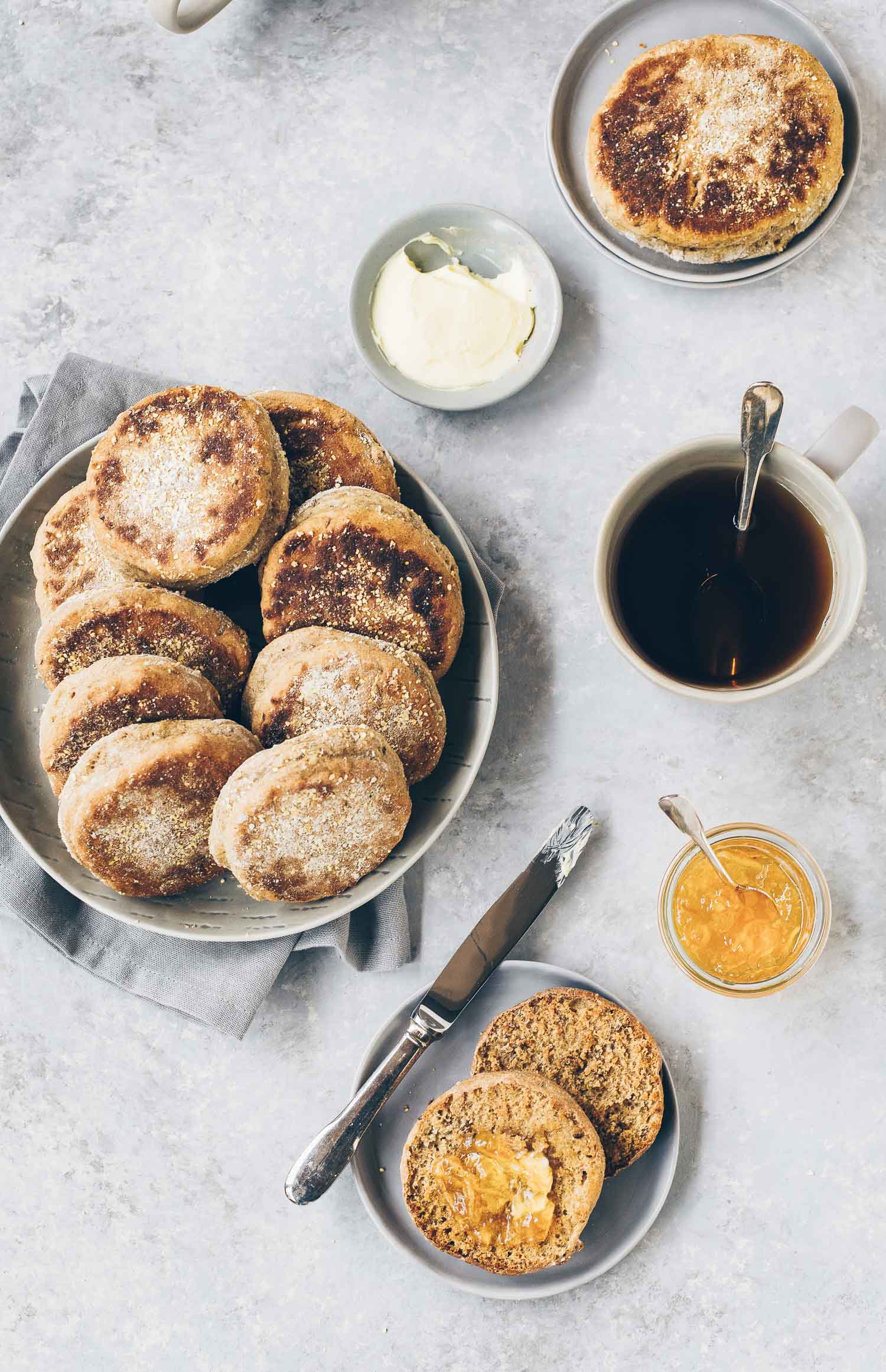
Our 17-year old kitty has taken to demanding breakfast around 5:30 each morning. Without fail, all winter, he would walk into the bedroom and begin his soft, little cries. My husband and I have figured out that if neither of us feels like getting up it is important not to make eye contact with or acknowledge Pilot’s presence–but he’s one smart kitty.
Pilot retired from catching his own meals years ago and he’s had us wrapped around his little paw for years–he knows that his persistence is always rewarded.
No reaction from us, fine. He knows that all he has to do is climb on the bed and get in our faces so it’s impossible to ignore him. My husband has always been the light sleeper/early riser in the family so the pre-sunrise wake up calls have moved up his breakfast routine, too.
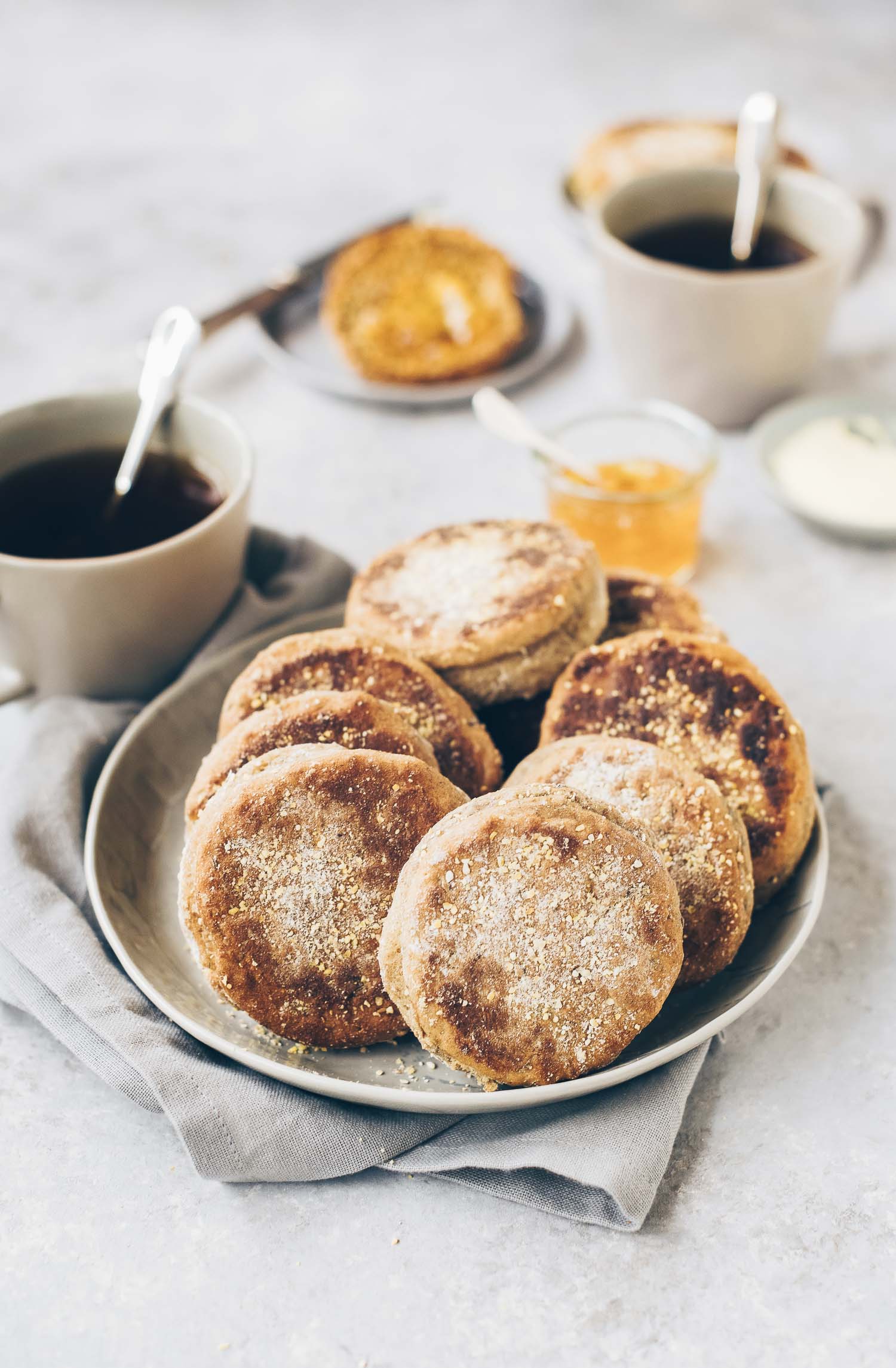
After serving the little prince a plate of his favorite-of-the-week fish-in-broth breakfast, my husband sleepily assembles his own: coffee, steel cut oatmeal, fruit, yogurt and for the past two years, English muffins…and he’s very particular about the last.
They can’t be doughy, heavy or sweet and they must be well-toasted. I’d been feeding my husband a specific brand of store-bought English muffins that have passed his muster until I remembered recently that when the sourdough bug first bit me a few years ago I shared a recipe for Sourdough Spelt English Muffins. It’s a solid recipe and one I still recommend. Bread is not as much of an enigma now and this latest batch of Sourdough Rye English muffins features one of my favorite flavor combinations–rye and caraway seeds–with a simpler technique.
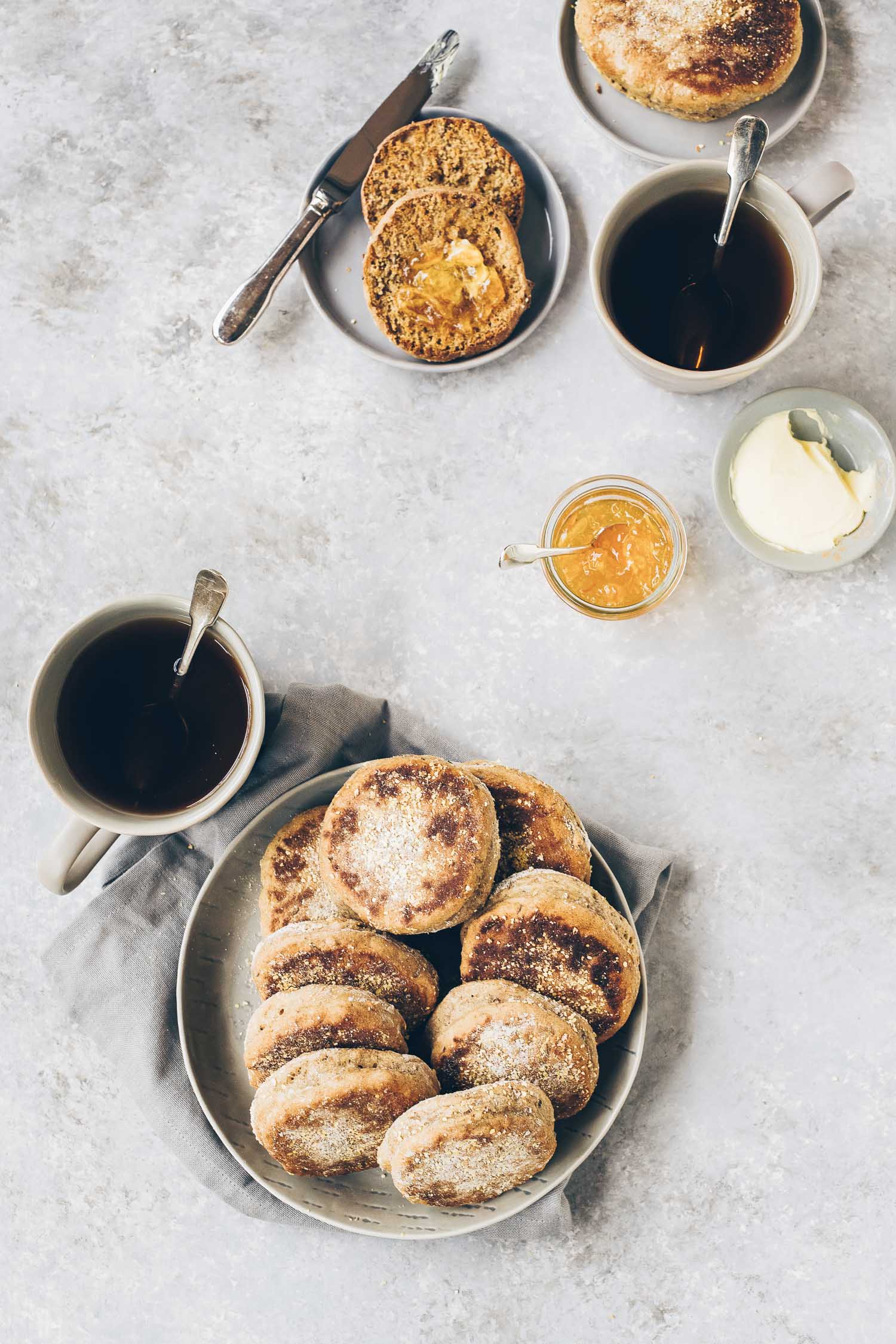
A Brief History of English Muffins
There are the muffins of old which “muffin men” (remember the one who lived on Drury Lane?) delivered door to door in England in the early nineteenth century. How close they are to the English muffins we know today is unclear based on my research but the latter were actually invented by an Englishman (Samuel Bath Thomas of Thomas’ English Muffins fame) after he moved to New York City in the late 1800s.
Mr. Thomas’ muffins were an adaptation of British crumpets. Both were made with a yeast-based dough out of flour, milk, salt, honey (or sugar) and cooked on a griddle using lard instead of butter. His creations were originally called toaster crumpets before being formally coined English muffins in 1926. Where traditional crumpets were soft and spongy and cooked only on one side using a crumpet ring, toaster crumpets were drier and were flipped and cooked on both sides, revealing the sought-after nooks and crannies when the muffins were split rather than being visible on top as with traditional crumpets.
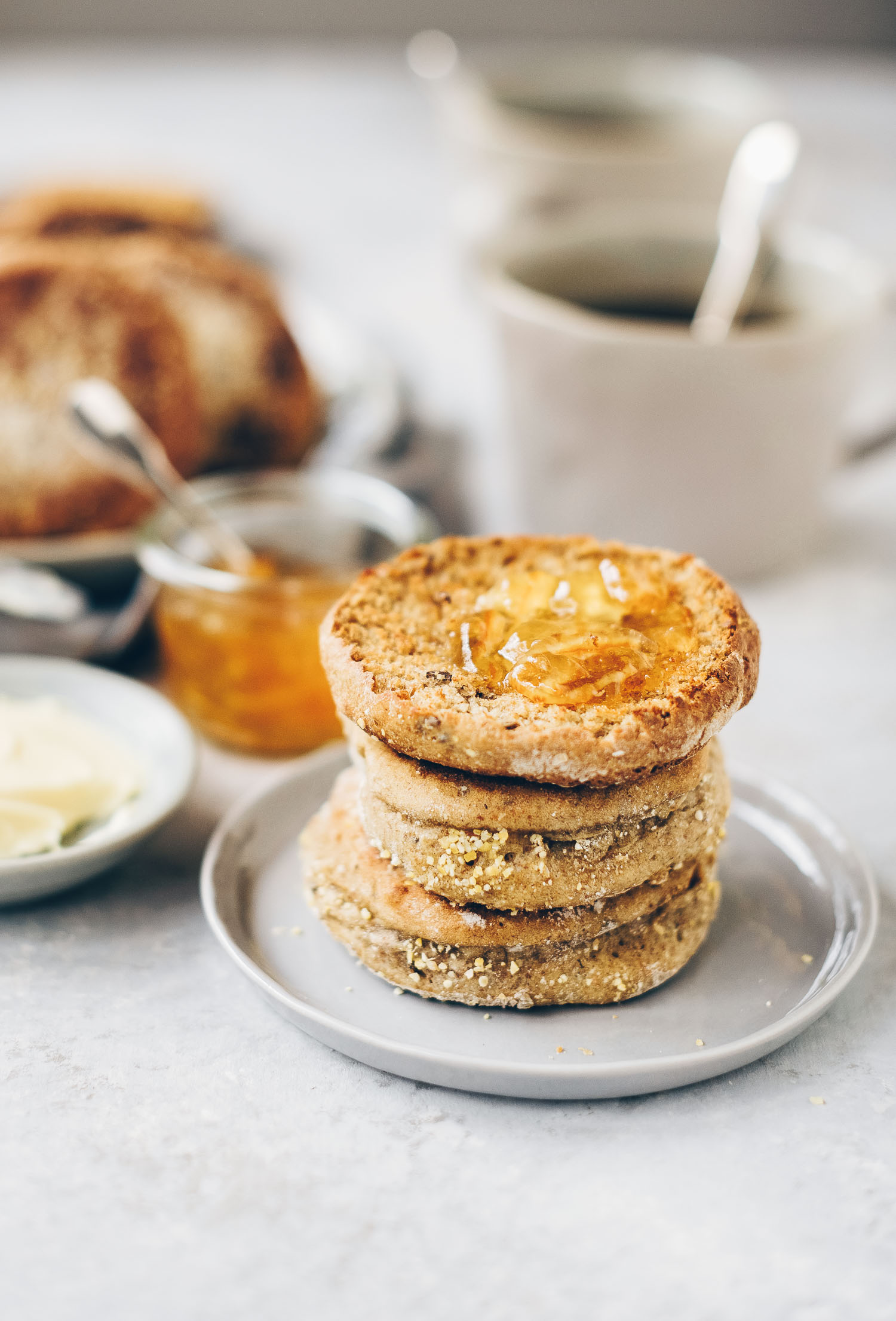
Sourdough English Muffins Using Sourdough Discard
English muffins have their start as a wet, sticky dough and it’s their minimal handling that yields a light, airy muffin, the perfect vessel for catching all the butter and jam you dare slather on top of them.
Later versions introduced baking soda as a leavening agent in addition to or instead of yeast. Because of an overnight rest required of most recipes, sourdough starter discard as a substitute for commercial yeast works well here. The overnight rest allows time for the spent starter to be “fed” by the flour and water, allowing for decent yeast activity. This recipe uses both starter and baking soda with great results.
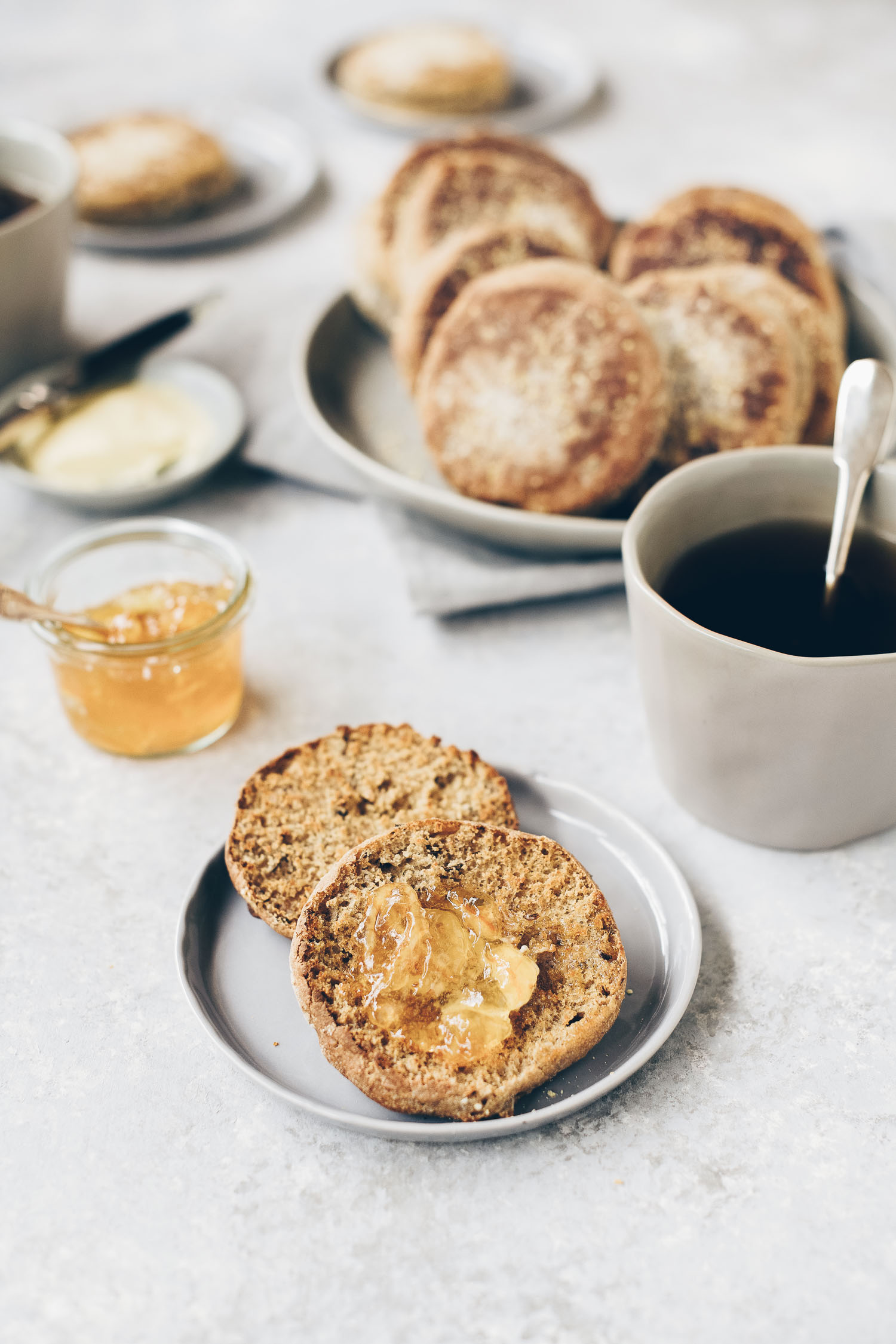
How to Make English Muffins
My older recipe for English muffins called for kneading the dough after the overnight rest but I found this not to be necessary and a welcome relief from having to manage the sticky dough. For this batch I went with the same simple stretch-and-fold technique called for in my Ken Forkish Sourdough bread. After this, the only active time involved in making these muffins is in cutting the rounds and cooking them. It’s so much easier than most would expect.
Sticking with tradition, these English muffins get their color and crisp exterior from a hot cast iron skillet brushed with a little butter. The short time on the stove also gives them and a nice lift, thanks to the joint efforts of the starter and baking soda. Not so traditionally, they are finished in the oven to keep the outsides from getting too dark.
The use of rye flour is less an ode to traditional English muffins that were made with whole grain flour and more about using the flavors I love, especially when paired with caraway seeds but feel free to simply use all-purpose flour or a blend of your favorites.
Toasted they are beautifully golden, craggy and have been hitting all the right notes with my husband…and me. I haven’t even minded our early morning wake up calls too much–the cat gets his tasty breakfast and so do we.
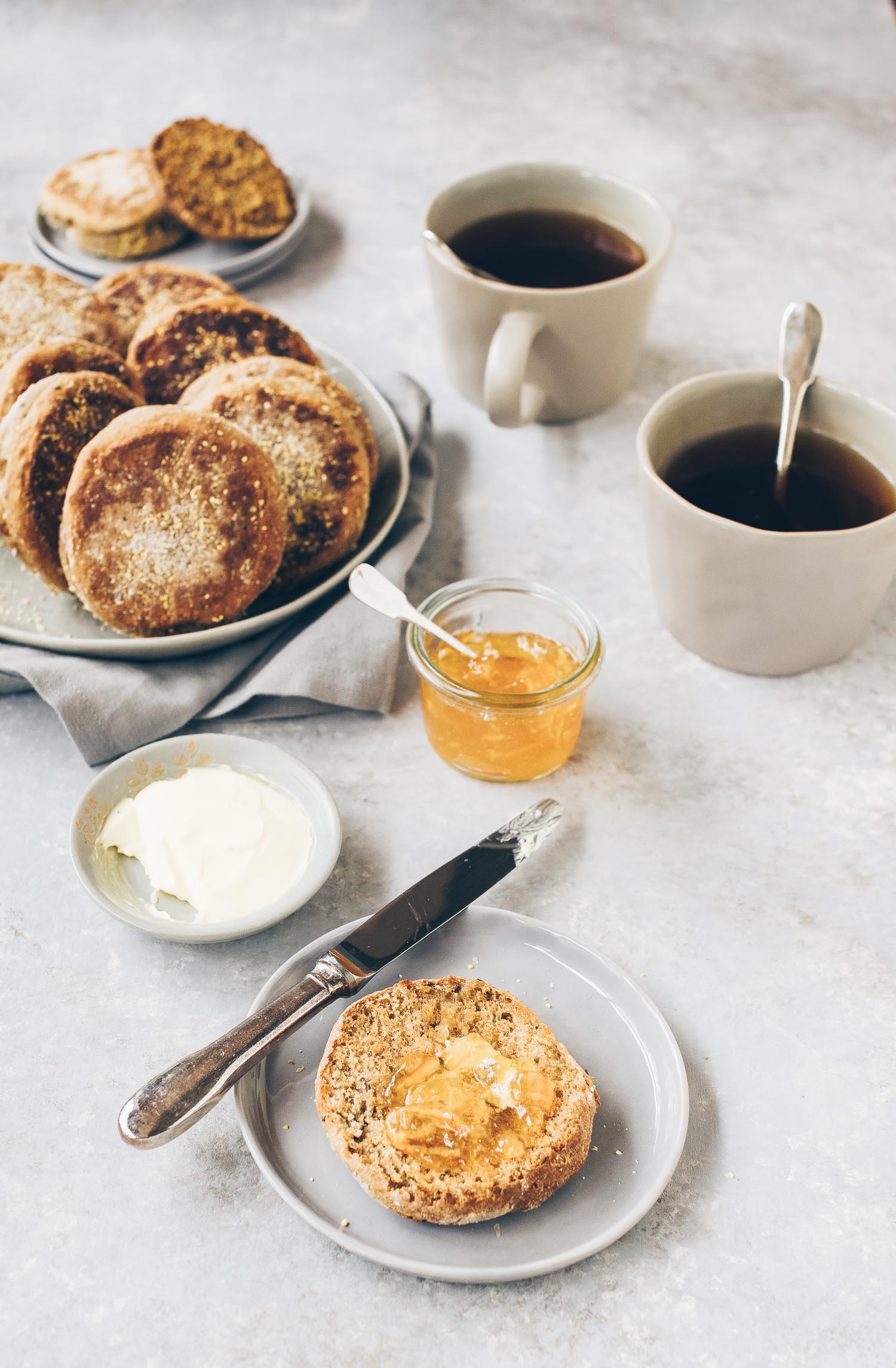
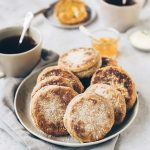
Sourdough Rye English Muffins
Ingredients
- 1/2 cup sourdough starter (freshly fed or discard)(126 grams)
- 1 cup milk (240 grams)
- 2/3 cup rye flour (85 grams)
- 1 1/3 cup all-purpose flour (169 grams)
- 1 tablespoon caraway seeds
- 1 tablespoon honey
- 3/4 teaspoon kosher salt
- 1 1/2 teaspoons baking soda
- cornmeal, for dusting
- 2-3 tablespoons butter for cooking
Instructions
The night before:
-
In a large bowl, stir together the starter and milk until well-combined. Add the flours and caraway seeds and stir until smooth. Cover the bowl with plastic wrap and a kitchen towel and let sit on the counter overnight, eight to twelve hours.
The following morning:
-
The dough should have increased in size overnight. Stir in the honey, salt and baking soda. The mixture will be sticky and loose and this is okay. Transfer the dough to a well-floured surface and sprinkle the top liberally with more flour. Take one portion of the dough, pull and fold over itself, keeping a ball shape. Repeat this several times, adding more flour as necessary. You may need to up to an additional 1/4-1/3 cup of flour. Note: A dough scraper would also be helpful in managing the dough by scraping from the bottom then folding the dough up over itself instead of using your hands.
-
Flatten the dough with your fingers to roughly 1/2 – 3/4 inch thick. Sprinkle a little more flour on top. Dust your round cutter with flour, too. I use one that is about 2 3/4 inches in diameter. Cut the dough into rounds and transfer the rounds on a baking tray generously dusted with corn meal. Lay the rounds on the baking tray. Shape the dough scraps into a ball and flatten again to collect more rounds. You should have 9-12 rounds, depending the size cutter you use. Dust the tops of the rounds with more corn meal then cover the tray with plastic wrap and leave to rest for 45 minutes to one hour.
Cook the English Muffins
-
Preheat your oven to 325ºF. Heat a cast iron skillet over medium heat and apply a light brushing of butter. Cooking in batches, cook each muffin for two minutes on each side or until lightly brown. Transfer the browned muffins on the same baking sheet (you don’t have to wipe off the corn meal). Finish the English muffins in the oven until they are cooked through, 10-15 minutes. Cool on a wire rack for a few minutes and enjoy. They are also great toasted the next day.






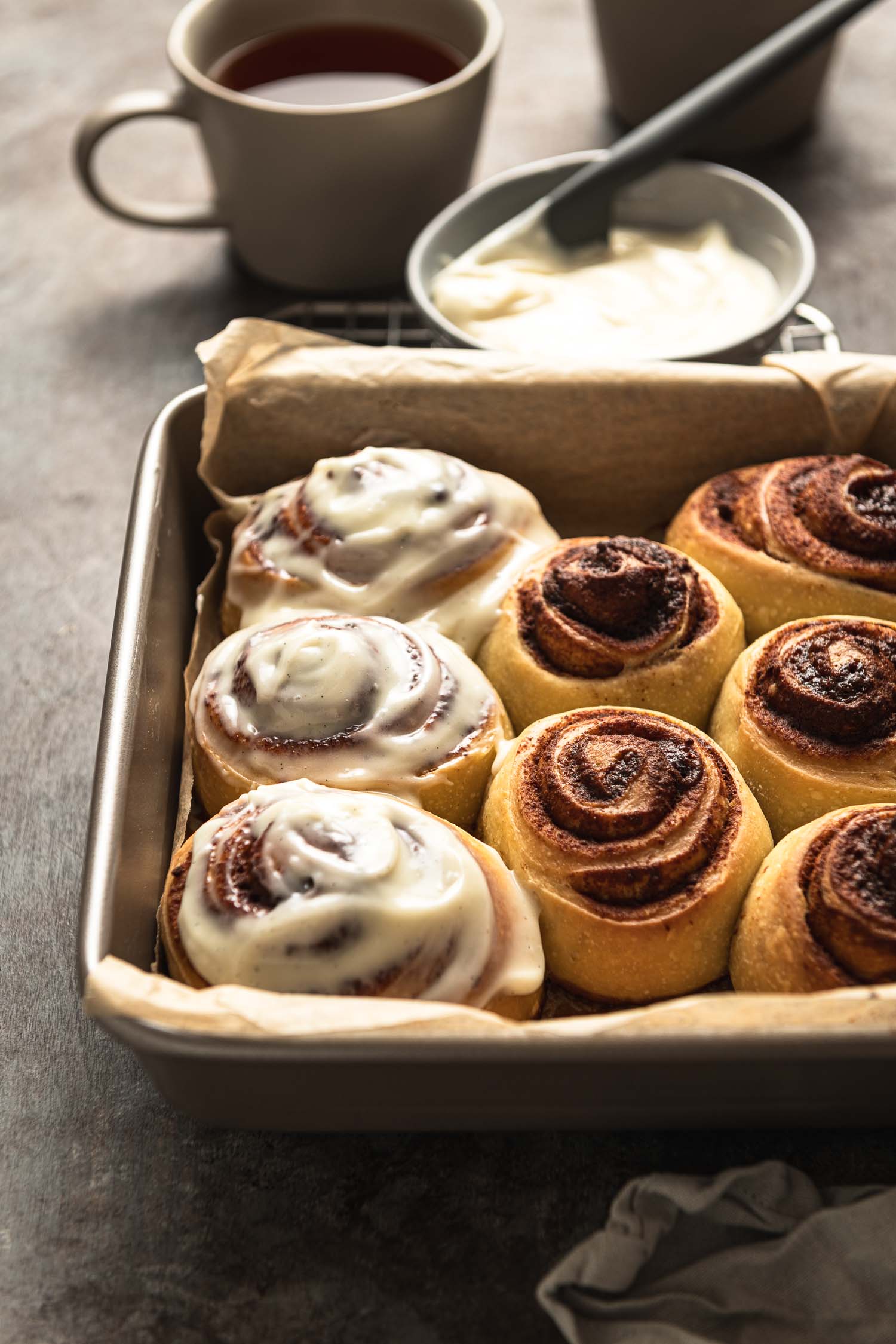
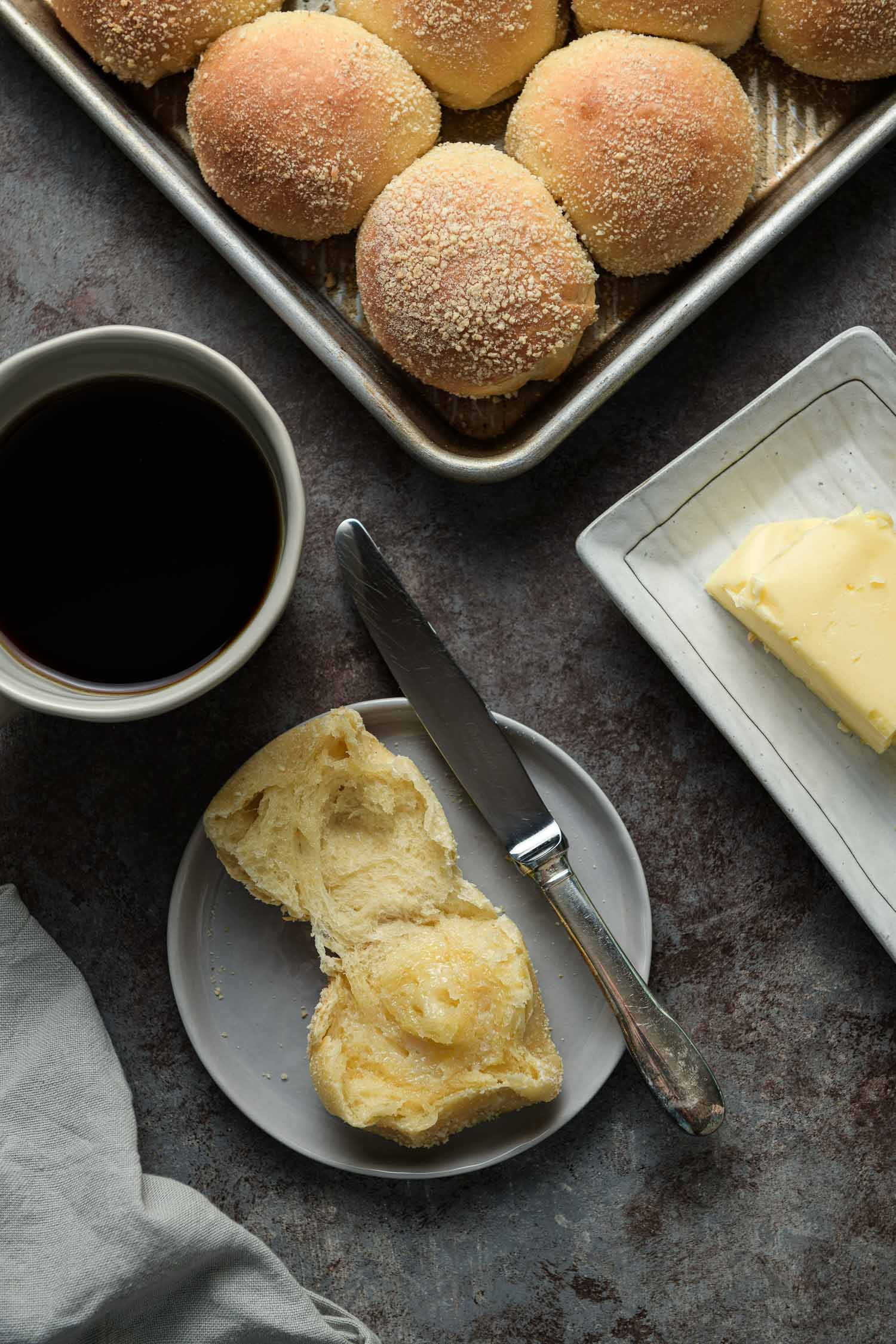
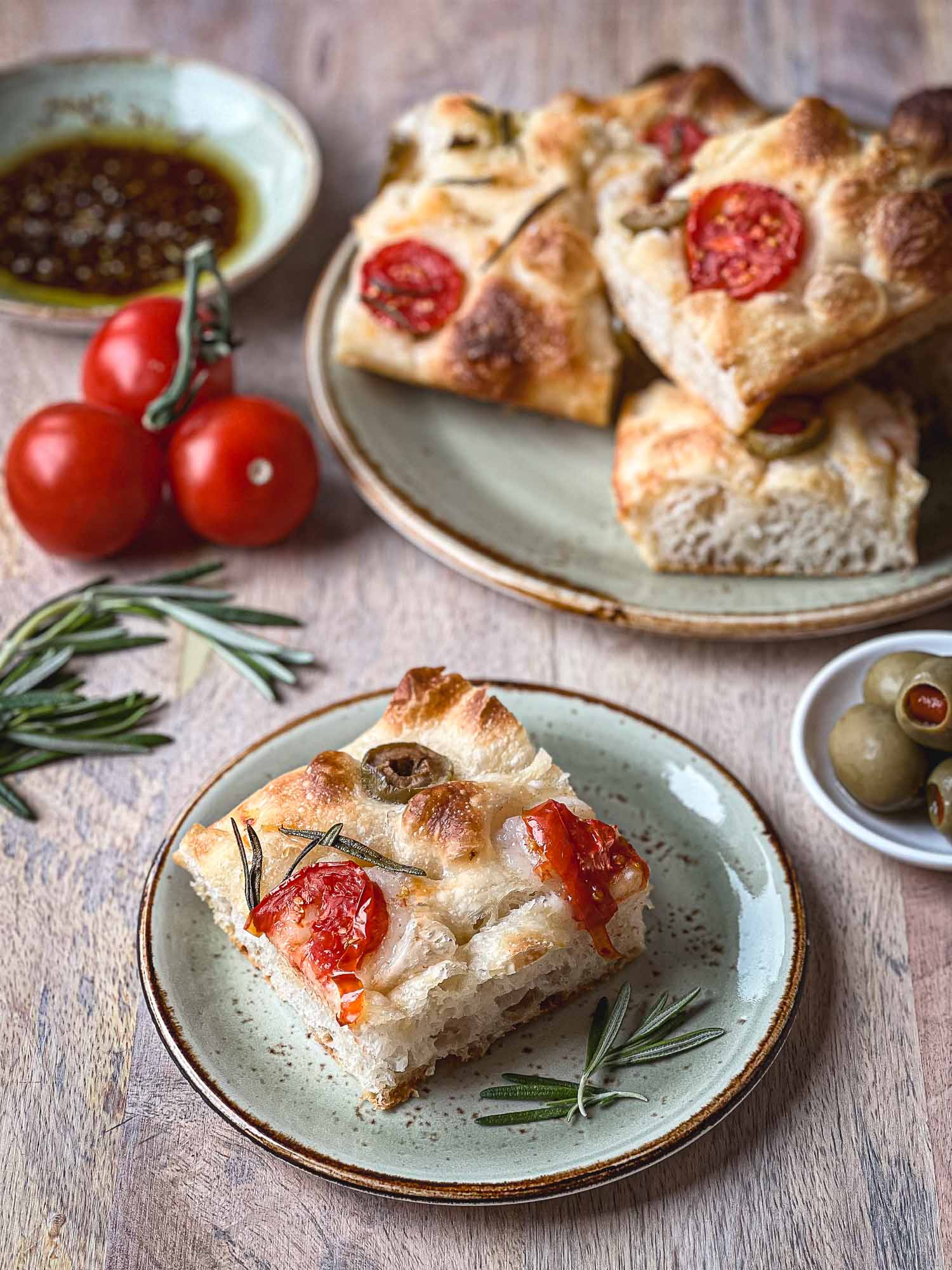

These look wonderful! I’ve never made English muffins of any kind. These with sourdough and rye flour are clearly tempting me!!!
This is the first time that I have ever made English Muffins and they were great! Thank you for the recipe. The caraway seeds were a delicious addition.
I’m so glad you liked this recipe, Dani. And I agree that the caraway seeds are great! Thanks for giving my recipe a chance. 🙂
I just finished making a double recipe. Very nice flavor, puffs up nice, & browns well in cast iron skillet! I haven’t got the timing to coincide with my sleep schedule yet! Looking forward to using these for Eggs Benedict too:) Was worried it was too dry & added water & more starter. The dough was very gooey, but it worked fine, albeit messy. Also used oat milk – didn’t have
regular. Thank you for the encouraging recipe. Will def make again!
Lisa, I’m so glad this recipe worked for you and thank you so much for taking the time to share your feedback! 🙂
I am about to try your english muffin recipe and was just wondering if you ever considered giving a metric option in your recipes. I have always preferred baking by weight measurements rather than cups. It’s so much more accurate.
Hi, Inge. I agree with you completely. In fact, most of my other sourdough recipes here are presented in gram measurements but with the English muffins, since my earliest recipe was in cups and I’ve used that as a base for the other recipes that have followed (including this one), I have taken for granted providing the gram measurements. I recently added the gram equivalents to my recipe for Sourdough Cinnamon Raisin English Muffins so I’m linking it here but I’ll also update this recipe. https://lemonsandanchovies.com/2020/03/sourdough-cinnamon-raisin-english-muffins/
I’m so happy I found your site after falling in love with sourdough baking. I’m getting ready to try the raisin cinnamon English muffin recipe and was wondering if the rye muffins can hold up to the 5 hr fermentation and then frig over night like these?
I’ve made many delicious recipes from your site and hope to see more soon? Any cookbooks on the market?
Sally
Sally, what a nice comment to read although I’m sorry for such a late reply. I hope the English muffin recipe worked out for you and that your fermentation time worked fine. Happy to answer any questions if you have any. (And no cookbook in the market but it would be a dream come true. 🙂 )
This recipe was delicious! I used my rye starter and nigella seeds instead of carraway seeds. I’m wondering – what percent hydration is the starter you’re using here? Mine is 150% by weight and the dough was so wet that these spread out a little thin. Wondering if my starter hydration might be the reason mine spread so much?
Hi, Jacob. Thanks so much for trying this recipe and I’m glad you liked it. My starter is 100% hydration and the dough itself is quite high in liquid already so I’m inclined to agree that the extra hydration in your starter may have caused the thinner dough. I’d say you can cut the milk amount back to make up for your higher hydration starter if you try this recipe again next time. Thanks so much for your feedback. 🙂
I just made them again with 100% hydration starter (I switched my hydration level for unrelated reasons) and they are perfect! This is the perfect way to use up discard. Thanks for a great recipe!
So glad this recipe worked out, Jacob!! 🙂
I made these during the Texas storm and they came out great! This was my first time making English muffins and I am happily surprised the rye did not take over the flavor of the muffin. I did not have a cast iron skillet to brown them in but my regular skillet seemed to work just fine in case anyone was wondering. Probably not the same toasting but again I didn’t have any issues. I was expecting more nooks and crannies in the center but I thought it was great even without them! Thank you for the great recipe!
Hi, Brittany. So glad this recipe worked out for you and thanks for the note about the skillet. Glad you and your family weathered the storm well. 🙂
I deviated quite a bit from the recipe by using a poolish in place of the sourdough starter, and doing an 8-hour rise at room temperature followed by an overnight proof in the fridge. But these were still delicious- tangy (though I’m sure not as much as proper sourdough) and a beautiful rye flavor! My recipe made 12, and we ate 6 in one day: trying one after it cooled, and then deciding to make breakfast sandwiches for dinner. I can’t wait to try the cinnamon raisin flavor! The ease of this recipe probably means it will be made many, many times in our kitchen!
Hi, Laura. I’m so glad you made this recipe your own and that it worked for you. All the credit to you! Sounds like English muffins will become a part of your regular rotation. 🙂
This was my first time making English muffins and I’ve just recently started working with sourdough. I made these with buttermilk and the came out absolutely amazing! I couldn’t bake them after the 8-12 period it was closer to 24 but it still worked great.
Karen, congrats on making your first English muffins! You’ll be hooked like the rest of us. Thanks so much for trying my recipe and I love your use of buttermilk.
Absolutely delicious!
Used my rye starter and they came out beautifully. Thanks so much for this great recipe – definitely a new favorite.
Maggie, I’m so glad this recipe worked for you. Thanks so much for giving it a try.
Made with AP einkorn, and a rye starter… had to do a couple batches to get it right with flour/hydration differences but wow! Once I figured it out, The flavor is so unique and delicious. My guy and I ate the whole batch in two days lol. Thanks for the recipe!!!